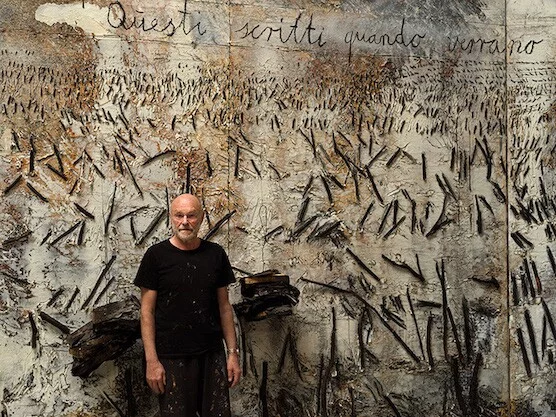Anselm Kiefer
Born in 1945 in Donaueschingen, Germany, Anselm Kiefer is one of the most important and versatile artists today. His artistic practice encompasses various media, including painting, sculpture, photography, printmaking, artist's books, installations, and architecture.
Kiefer studied law and Romance languages before turning to art studies at the academies of Freiburg and Karlsruhe. As a young artist, he came into contact with Joseph Beuys and participated in his action Save the Woods in 1971.
With his early works, he addressed the history of the Third Reich and grappled with post-war German identity as a means to break the silence on the recent past. Through parodying the Nazi salute or visually quoting and deconstructing Nazi architecture and Germanic myths, Kiefer explored his own identity and culture.
From 1971 until his move to France in 1992, Kiefer worked in the Odenwald region of Germany. During this time, he began to incorporate into his work materials and techniques that are now emblematic, such as lead, straw, plants, fabrics, and woodcuts, along with themes like Wagner's Ring Cycle, the poetry of Paul Celan and Ingeborg Bachmann, as well as biblical references and Jewish mysticism.
The artist gained international attention when he, along with Georg Baselitz, represented West Germany at the 39th Venice Biennale in 1980.
The mid-1990s marked a shift in his work; extended trips to India, Asia, America, and North Africa inspired an interest in the exchange of thought between the Eastern and Western worlds, and structures reminiscent of Mesopotamian architecture entered his oeuvre. There are evident nods to the landscapes of southern France, with depictions of constellations or the inclusion of sunflower plants and seeds.
Kiefer, an avid reader, enriches his works with layered literary and poetic references. These associations are not necessarily fixed or literal but overlap in an interconnected fabric of meaning, and his interest in books, both as text and object, reverberates in his work. Since the beginning of his career, artist's books have constituted a significant part of his production.
In addition to creating paintings, sculptures, books, and photographs, Anselm Kiefer has intervened in various sites. After transforming an old brick factory in Höpfingen, Germany, into a studio, he created installations and sculptures that became part of the place itself. Several years after his move to Barjac, France, Kiefer again transformed the property around his studio by digging to create a network of underground tunnels and crypts connected to art installations.
The studio is now part of the Eschaton-Anselm Kiefer Foundation, regularly open to the public. The establishment of the foundation in 2022 coincided with Kiefer's return to Venice where, parallel to the Biennale, he inserted a series of paintings inspired by the writings of the Italian philosopher Andrea Emo into the Doge's Palace.
Anselm Kiefer currently works and lives near Paris.
(source: Palazzo Strozzi exhibition)
Last update: February 10, 2024

Mostre ed eventi pubblicati su Itinerarinellarte.it
Contemporary artexhibitions Firenze
Anselm Kiefer: Fallen Angels
From March 22nd to July 21st, 2024, Palazzo Strozzi hosts a major exhibition dedicated to one of the greatest masters of art between the 20th and 21st centuries, Anselm Kiefer.
 itinerarinellarte.it è un sito che parla di arte in Italia coinvolgendo utenti, musei, gallerie, artisti e luoghi d'arte.
itinerarinellarte.it è un sito che parla di arte in Italia coinvolgendo utenti, musei, gallerie, artisti e luoghi d'arte.